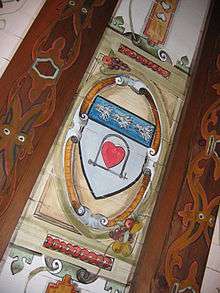Simon Locard
| Sir Symon (Simon) Locard (Lockhart) | |
|---|---|
| Born | 1300 |
| Died |
1371 Unknown |
| Occupation | Knight |
| Spouse(s) | Unknown |
| Children | Sir Alexander Lockhart (1350–1444), 3rd of Lee |
| Parent(s) | Sir Stephen Locard (d. 1320) |
Sir Symon Locard, 2nd of Lee (1300–1371) was a Scottish knight who fought in the Wars of Scottish Independence. He accompanied Sir James Douglas in their curtailed attempt to carry the heart of Robert the Bruce to the Holy Land in 1330.[1]
Family
Symon was the grandson of another Sir Symon Locard (1236–1286) who was knighted by King Alexander III (r.1249-1286), and acquired the lands of Craiglockhart. This Symon had two children, Malcolm and Stephen. Stephen died in 1320, leaving Symon Locard as successor to the 'Lands of Lee.'
Mission to the Holy Land
Following the death of Robert the Bruce in 1329, his companion Sir James Douglas (aka the "Black Douglas"), set out to fulfil the King's last wish, that his heart be taken to the Holy Land, to be deposited in the Holy Sepulchre at Jerusalem. King Robert's heart was placed in a silver casket, which was carried by Sir James, while Sir Symon Locard was entrusted with the key:
“In 1329 a band of Scottish knights set out to fulfil the last wish of their dead King. Their leader, Lord James Douglas, carried the King’s heart in ‘ane cas of silver fyn, enamilit throu subtilite’ hung about his neck. Beside him rode Sir Symon Locard, carrying the key of the casket. Sir Symon had won fame and distinction in the wars against the English; and now he was entrusted with the key of the precious casket.”.[2]
The two knights, with six other knights and twenty-six squires and gentlemen, set out from Montrose in 1330. Stopping a Sluys in Flanders, they heard of the crusade of Alfonso XI of Castile against the Muslim Emirate of Granada. Sailing to Seville, they joined Alfonso's army and took part in the Battle of Teba. Most of the Scots were killed, including Sir James Douglas, Sir William St. Clair of Rosslyn and Sir Robert Logan of Restalrig. The body of Sir James, and the casket, were recovered from the field, and were carried back to Scotland by Sir Symon Locard and Sir William Keith of Galston.
Origin of the surname Lockhart

It is said that, following these events, Sir Symon changed his surname to Lockheart, later Lockhart, as the only holder of the key to the locked casket. He added a heart and fetterlock to the family coat of arms, and the motto Corda Serrata Pando: "I open locked hearts". Sir Symon lived into his 70s, dying in 1371 at the beginning of the reign of Robert II (1371–1390).
The Lee Penny
At the battle of Teba, Sir Symon captured a wealthy Emir, whom he held ransom. When the emir's mother came to ransom him, she paid with an amulet, which she claimed had medicinal properties. The amulet could be dipped into water to make the water antipyretic, for fever reduction, and hemostatic to restrict bleeding. Sir Symon made use of the amulet in Spain and in Scotland, and its healing powers became widely known. The amulet became known as the Lee Penny, after the family seat of Lee Castle near Lanark, and remains in the possession of the Lockhart family. The story of the Lee Penny formed the basis for Sir Walter Scott's 1825 novel The Talisman.
Notes
- ↑ Douglas, Sir Robert. The Baronage of Scotland. Edinbugh, 1798, p. 324.
- ↑ Lockhart, Simon Macdonald. Seven Centuries - A History of the Lockharts of Lee and Carnwath. Scotland, 1976
References
- Sir Robert Douglas, The Baronage of Scotland, 1798
- Simon Macdonald Lockhart, Seven Centuries - A History of the Lockharts of Lee and Carnwath, 1976
- Forbes Macgregor, Famous Scots - the Pride of a Small Nation